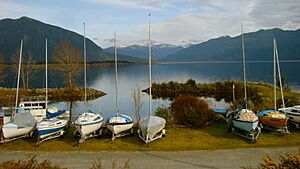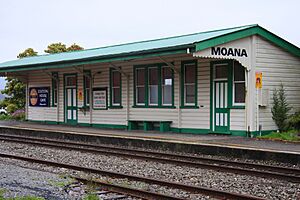Moana, New Zealand facts for kids
Quick facts for kids
Moana
|
|
|---|---|

View of Lake Brunner from Moana
|
|
| Country | New Zealand |
| Region | West Coast |
| District | Grey District |
| Ward | Eastern |
| Electorates |
|
| Area | |
| • Total | 1.16 km2 (0.45 sq mi) |
| Population
(June 2023)
|
|
| • Total | 70 |
| • Density | 60/km2 (156/sq mi) |
| Local iwi | Ngāi Tahu |
Moana is a small town in the West Coast Region of the South Island of New Zealand. It is situated on the northern shore of Lake Brunner, and is beside the outflow of the lake into the Arnold River. There is a pedestrian suspension bridge crossing the Arnold from the town to access the lake shore across the river, with some short easy bush walks on each side.
The town has a permanent population of less than 100, but is a popular location for summer tourism. There are around 300 holiday homes and a camping ground.
The town's main tourist attractions are the panoramic views and water sport opportunities arising from its position on the shores of Lake Brunner. The Midland Line railway passes through Moana; the TranzAlpine tourist passenger train passes through once in each direction daily, and freight trains of coal operate more frequently.
In May 2013, Moana became one of the first places in New Zealand to get 4G wireless broadband.
Demographics
Moana is described by Statistics New Zealand as a rural settlement and covers 1.16 km2 (0.45 sq mi). It had an estimated population of 70 as of June 2023, with a population density of 60 people per km2. Moana is part of the larger Lake Brunner statistical area.
| Historical population for Moana | ||
|---|---|---|
| Year | Pop. | ±% p.a. |
| 2006 | 63 | — |
| 2013 | 66 | +0.67% |
| 2018 | 57 | −2.89% |
Before the 2023 census, the settlement had a smaller boundary, covering 0.58 km2 (0.22 sq mi). Using that boundary, Moana had a population of 57 at the 2018 New Zealand census, a decrease of 9 people (−13.6%) since the 2013 census, and a decrease of 6 people (−9.5%) since the 2006 census. There were 30 households, comprising 33 males and 27 females, giving a sex ratio of 1.22 males per female. The median age was 58.4 years (compared with 37.4 years nationally), with 6 people (10.5%) aged 15 to 29, 33 (57.9%) aged 30 to 64, and 18 (31.6%) aged 65 or older.
Ethnicities were 89.5% European/Pākehā, 10.5% Māori, 5.3% Pasifika, and 5.3% other ethnicities. People may identify with more than one ethnicity.
Although some people chose not to answer the census's question about religious affiliation, 52.6% had no religion, 36.8% were Christian, and 5.3% were Buddhist.
Of those at least 15 years old, 9 (15.8%) people had a bachelor's or higher degree, and 9 (15.8%) people had no formal qualifications. The median income was $33,900, compared with $31,800 nationally. 6 people (10.5%) earned over $70,000 compared to 17.2% nationally. The employment status of those at least 15 was that 27 (47.4%) people were employed full-time, and 12 (21.1%) were part-time.
Lake Brunner statistical area
Lake Brunner statistical area, which also includes Gloriavale, covers 1,301.70 km2 (502.59 sq mi) and had an estimated population of 1,220 as of June 2023, with a population density of 0.94 people per km2.
| Historical population for Lake Brunner | ||
|---|---|---|
| Year | Pop. | ±% p.a. |
| 2006 | 753 | — |
| 2013 | 918 | +2.87% |
| 2018 | 1,065 | +3.02% |
Lake Brunner had a population of 1,065 at the 2018 New Zealand census, an increase of 147 people (16.0%) since the 2013 census, and an increase of 312 people (41.4%) since the 2006 census. There were 186 households, comprising 531 males and 534 females, giving a sex ratio of 0.99 males per female. The median age was 20.4 years (compared with 37.4 years nationally), with 444 people (41.7%) aged under 15 years, 213 (20.0%) aged 15 to 29, 330 (31.0%) aged 30 to 64, and 75 (7.0%) aged 65 or older.
Ethnicities were 95.8% European/Pākehā, 4.5% Māori, 0.8% Pasifika, 1.7% Asian, and 1.7% other ethnicities. People may identify with more than one ethnicity.
The percentage of people born overseas was 7.0, compared with 27.1% nationally.
Although some people chose not to answer the census's question about religious affiliation, 26.8% had no religion, 68.2% were Christian and 0.3% had other religions.
Of those at least 15 years old, 78 (12.6%) people had a bachelor's or higher degree, and 90 (14.5%) people had no formal qualifications. The median income was $25,900, compared with $31,800 nationally. 51 people (8.2%) earned over $70,000 compared to 17.2% nationally. The employment status of those at least 15 was that 357 (57.5%) people were employed full-time, 87 (14.0%) were part-time, and 6 (1.0%) were unemployed.
Education
Lake Brunner School is a coeducational full primary (years 1–8) school with a roll of 44 students as of February 2024. Rotomanu School closed and merged into this school in 2005.
Railway station
In 1886, the New Zealand Midland Railway Company entered a contract with the Government for the construction of 376 kilometres (234 mi) of railway between Christchurch and Nelson via Brunnerton (later Brunner) over a ten year period. The line was to be built and operated by private enterprise. In November 1892, the company opened the railway from Brunnerton, but at that stage Moana was only a flag station. By March 1894, the railway had reached Jacksons. However, in 1895 the company collapsed. In May 1895 the Government seized the company's assets on the grounds that the contract had expired with the works incomplete. The Government eventually completed the works under the Railways Construction and Land Act 1881.
The opening of the railway to Moana enabled settlement by Pākeha and establishment of timber mills in the local area. By June 1895 a 140 metres (460 ft) siding was being operated at Moana station by the Lake Brunner Sawmill Company. The date of construction of the original Moana railway station building is not known, but by 1895 the station had a 61 metres (200 ft) long platform and 240 metres (790 ft) siding.
On 16 April 1926, the station building was destroyed in a fire. A replacement building was constructed in the same year. The replacement was to the standard type A design, from the family of standard railway station designs prepared by Railways architect George Troup.
The Moana Railway Station is listed as a Category 1 Historic Place by Heritage New Zealand. It is the only type A station building still remaining that is complete with its associated sidings and goods sheds. Heritage New Zealand has also given a Category 1 listing to the Moana Railway Station Historic Area comprising the station building, a footbridge, the goods shed and the former station master’s house (now used as a cafe).



